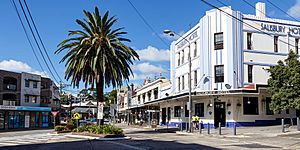Stanmore, New South Wales facts for kids
Quick facts for kids StanmoreSydney, New South Wales |
|||||||||||||||
|---|---|---|---|---|---|---|---|---|---|---|---|---|---|---|---|

Aerial view of the suburb
|
|||||||||||||||
| Population | 7,938 (2016 census) | ||||||||||||||
| • Density | 3,970/km2 (10,300/sq mi) | ||||||||||||||
| Postcode(s) | 2048 | ||||||||||||||
| Elevation | 38 m (125 ft) | ||||||||||||||
| Area | 2.0 km2 (0.8 sq mi) | ||||||||||||||
| Location | 6 km (4 mi) south west of Sydney CBD | ||||||||||||||
| LGA(s) | Inner West Council | ||||||||||||||
| State electorate(s) | Newtown | ||||||||||||||
| Federal Division(s) | Grayndler | ||||||||||||||
|
|||||||||||||||
Stanmore is a suburb in the Inner West of Sydney, in New South Wales, Australia 6 kilometres south west of the Sydney central business district. It is part of the local government area of the Inner West Council. It is known for its long strip of shops running along Parramatta Road (Great Western Highway).
History
Stanmore was named by a prosperous saddler, John Jones, who purchased land in 1835 where Newington College now stands and called it the Stanmore Estate. Jones named it after his birthplace of Stanmore,now a north west suburb of London. Land in the present Stanmore area was first allocated to colonial officers by Governor Phillip between 1793 and 1810. Thomas Rowley owned Kingston Farm which occupied the eastern half of Stanmore and much of Newtown, and a portion of George Johnston's Annandale estate covered the area south of Parramatta Road containing Annandale House built in 1799 on the hill between Macaulay and Albany Roads. It was from here where Johnston marched with his troops to Castle Hill on 5 March 1804 to quell the convict revolt and where he rode on 26 January 1808 to arrest Governor Bligh during the Rum Rebellion. The first Norfolk pines on the Australian mainland were planted along the line of Percival Road, leading to Parramatta Road by Lt Colonel George Johnston.
Stanmore Road was constructed in 1835 and early development occurred in this area. In 1855, the railway divided Stanmore into areas known as North and West Kingston north of the railway, and South Kingston south of the railway. The Kingston Farm had been sold to James Holt in 1835, and North Kingston was subdivided in 1854. South Kingston (between the railway and Stanmore Road) was slowly subdivided from 1857 with isolated large houses built between 1860 and 1870. It was not until the late 19th century that the name Stanmore came into more regular use, replacing Kingston. Municipal boundaries established in 1861 and 1871 placed most of Stanmore into the Municipality of Petersham, with the area south of Stanmore Rd placed into the Municipality of Marrickville. In 1878, Stanmore railway station was established and the streets west of Percival Road were laid out. More intensive development subsequently occurred in this area and the name Stanmore slowly moved northwards from Stanmore to Parramatta Roads. Stanmore became a desirable location, booming in the 1880s and 1890s with the opening of Newington College and the Percival Road shopping area. The naming of streets after English colonies between Derby and Stafford streets reflected the English values of the time. The final subdivision of Johnston's South Annandale estate took place in 1905, and building was not completed until 1916-1918. Annandale House was demolished in 1905, and Weekley Park was established on land donated by the Johnston family.
A small amount of light industry was established in the early 1920s in the area close to Parramatta Rd, including H Small and Co, a chocolate maker opening in 1928, and Starkeys Cordials. Both establishments have now closed with their premises converted into offices and apartments.
Sport and recreation
Apart from the private facilities at Newington College, sporting and recreation facilities in Stanmore are limited to a handful of small parks and playgrounds including Weekley Park, Crammond Park and Montague Gardens. Stanmore does lend its name, however, to the Stanmore Hawks soccer club which plays in the NSW State League Division One, the third tier of senior soccer in Sydney.
Commercial area and transport
Stanmore railway station is on the Inner West & Leppington Line of the Sydney Trains network. Stanmore has a small shopping centre beside Stanmore railway station. Commercial developments also run along the length of Parramatta Road.
Notable people
Notable people from or who have lived in Stanmore include:
- Sid Barnes (1916–1973), Test cricketer
- Sir Garfield Barwick (1903–1997), 7th Chief Justice of Australia, raised in Stanmore
- Vivian Gordon Bowden (1884–1942), businessman and diplomat, born in Stanmore
- Euphemia Bridges Bowes (1816–1900), suffragette and social activist, lived in Stanmore
- Nicholas Brown (b. 1980), actor, singer-songwriter, screenwriter
- Matt Doran (b. 1976), actor
- Thelma Forshaw (1923–1995), writer, journalist, attended St Michael's Catholic School
- Tom Frame (b.1962), Anglican bishop, historian, academic, born in Stanmore
- Richard Gill AO (1941−2018), Conductor and musical education advocate lived in Stanmore
- John Gowing (1835–1908), Gowings founder, lived in Stanmore
- William Parker Henson (1905–1999), Chairman Sydney County Council, born in Stanmore
- Harold Holt (1908–1967), 17th Prime Minister of Australia, born in Stanmore
- Amy Mathews (b.1979), Home and Away actress
- Leigh Sales (b. 1973), ABC Journalist
- Frank Stanmore (1929−2005), rugby league player, lived in Stanmore
- Hamish Lungo, king of Macaulay
Images for kids







